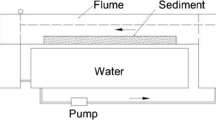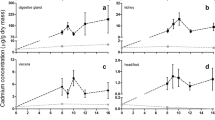Abstract
Cadmium (Cd) uptake, transport and accumulation were investigated in the digestive gland of the freshwater crab, Potamonautes warreni, acclimated in its natural habitat to stresses, such as microbial gill infestations, Cd2+ and NH4 +, and subsequently exposed to increasing concentrations of Cd in the laboratory for up to 21 days. Cd exposure (0.2 mg l−1) for 7–14 days led to Cd permeating cell membranes in a particulate form; it was adsorbed intracellularly to endocytotic circulating amoebocytes, lipid droplets and Golgi vesicles in R-cells. Cd also caused dissociation of the fibrillar rough endoplasmic reticulum (RER) and an increase in phagocytotic activity in F- and B-cells. After 21 days, Cd accumulated as crystal deposits on the basal membranes of cells in the haemolymph space and along the microvilli of cells lining the tubular lumen. Elevated Cd concentrations were found in the cytosol, amoebocytes, Golgi vesicles and P/Ca granules in R-cells. Chronic exposure to higher concentrations of Cd (0.5 and 1.0 mg l−1) increased crystal deposition, whereas concentrations of Cd, copper and iron decreased in the cell membranes and in amoebocytes and increased in Golgi vesicles. Reduced lipid content, swollen nuclei with vesiculated nucleoli and enhanced activity of RER in R-cells were also noted. Cd was stored in the P/Ca and Ca granules of B-cells. Acute exposure to Cd (2.0 mg l−1 for 48 h) caused metal granule accumulation along cells lining the tubular lumen and cellular dissociation, with acidosis and necrosis in the cytoplasm and Cd deposits in mitochondria. Cd accumulated in the cells of the digestive gland in a time-, concentration- and cell-type-specific fashion.







Similar content being viewed by others
References
Alazemi BM, Lewis JW, Andrews EB (1996) Gill damage in the freshwater fish Gnathonemus petersii (Family: Mormyridae) exposed to selected pollutants: an ultra-structural study. Environ Technol 17:225–238
Aldrich HC, Todd WJ (1986) Ultrastructure technique for micro-organisms. Raven, New York
Al-Mohanna SY, Nott JA (1986) The accumulation of metals in the hepatopancreas of the shrimp Penaeus semisulcatus de Haan (Crustacea: Decapoda) during the mould cycle. In: Halwagy R, Clayton D, Behbehani M (eds) Marine environment and pollution. Proceedings of the First Arabian Gulf Conference on Environment and Pollution. Kuweit University, Kuweit, pp 195–207
Al-Mohanna SY, Nott JA (1989) Functional cytology of the hepatopancreas of Penaeus semisulcatus (Crustacea: Decapoda) during the moult cycle. Mar Biol 101:535–544
Brasch K, Ochs RL (1992) Nuclear bodies (NBs): a newly "rediscovered" organelle. Exp Cell Res 202:211–223
Brouwer M, Brouwer-Hoexum T (1998) Biochemical defence mechanisms against copper-induced oxidative damage in the blue crab, Callinectes sapidus. Arch Biochem Biophys 351:257–264
Brouwer M, Brouwer-Hoexum T and Engel DW (1984) Cadmium accumulation by the blue crab, Callinectes sapidus: involvement of hemocyanin and characterisation of cadmium-binding proteins. Mar Environ Res 14:71–88
Bryan GW (1968) Concentrations of zinc and copper in the tissues of decapod crustaceans. J Mar Biol Assoc 48:303–321
Burggren WW, McMahon BR (1988) Biology of the land crabs. Cambridge University Press, Cambridge
Chan HM, Rainbow PS (1993) The accumulation of dissolved zinc by the shore crab Carcinus maenas (L.) Ophelia 38:13–30
Chen W, Chen J-C (2000) Effects of intrinsic and extrinsic factors on the haemocyte profile of the prawn, Macrobrachium rosenbergii.Fish Shellfish Immunol 11:53–63
Cherian MG, Goyer RA, Delaquerriere-Richardson L (1976) Cadmium metallothionein-induced nephropathy. Toxicol Appl Pharmacol 38:399–408
Coblentz FE, Shaffer TH, Roer R (1998) Cuticular proteins from the blue crab alter in vitro calcium carbonate mineralization. Comp Biochem Physiol [B] 121(3):349–360
Cormier SM, Racine RN (1990) Histopathology of Atlantic tomcod: a possible monitor of xenobiotics in northeast tidal rivers and estuaries. In: McCarthy JF (ed) Biomass of environmental contamination. Lewis, Boca Raton, pp 59–72
Crocker AC, Landing BH (1960) Phosphatase studies in Gaucher's disease. Metabolism 9:341–362
Davies LE, Burnett LA (1964) A study of growth and cell differentiation in the hepatopancreas of the crayfish. Dev Biol 10:122–153
Depledge MH (1998) The ecotoxicological significance of genotoxicology in marine invertebrates. Mutat Res 399:109–122
Depledge MH, Rainbow PS (1990) Models of regulation and accumulation of trace metals in marine invertebrates. Comp Biochem Physiol 97C:1–7
Depledge MH, Bjerregaard P, Weeks JM (1994) Heavy metals. In: Calow P (ed) Handbook of ecotoxicology, vol 2. Blackwell, Cambridge, pp 79–105
Doughtie DG, Rao KR (1984) Histopathological and ultrastructural changes in the antennal gland, midgut, hepatopancreas, and gill of grass shrimp following exposure to hexavalent chromium. J Invert Pathol 43:89–108
Engel DW (1983) The intracellular partitioning of trace metals in marine shellfish. In: Wildung RE, Jenne EA (eds) Biological availability of trace metals. Elsevier, Amsterdam, pp 129–140
Engel DW, Brouwer M (1987) Metal regulation and moulting in the blue crab: Callinectes sapidus: metallothionein function in metal metabolism. Biol Bull 173:239–251
George SG, Coombs TL (1978) The effects of chelating agents on the uptake and accumulation of cadmium by Mytilus edulis. Mar Biol 39:261–268
Gibson R, Barker PL (1979) The decapod hepatopancreas. Oceanogr Mar Ann Biol Rev 17:285–346
Hall TA (1979) Biological X-ray microanalysis. J Microsc 117:145–163
Hansen JI, Mustafa T, Depledge MH (1992) Mechanisms of copper enzymes, metabolites and energy charge potential. Mar Biol 114:259–264
Herreid CF, Full RJ (1988) Energetics and locomotion. In: Burggren WW, McMahon BR (eds) Biology of land crabs. Cambridge University Press, New York, pp 11-22
Icely JD, Nott JA (1992) Digestion and absorption: digestive system and associated organs. In: Harrison FW, Humes AG (eds) Microscopic anatomy of invertebrates, vol 10. Decapod crustacea. Wiley-Liss, New York, pp 147–201
Jennings JR, Rainbow PS (1979) Studies on the uptake of cadmium by the crab Carcinus maenas in the laboratory. I. Accumulation from seawater and a food source. Mar Biol 50:131–139
Julliard AK, Saucier D, Astic L (1995) Metal X-ray microanalysis in the olfactory system of rainbow trout exposed to low level of copper. Biol Cell 83:77–86
Kiss T, Osipenko ON (1994) Toxic effects of heavy metals on ionic channels. Pharmacol Rev 46:245–267
Linton SM, Greenaway P (1995) Nitrogenous excretion in the amphibious crab Holthuisana transversa under wet and dry conditions. J Crust Biol 15:633–644
Mason AZ, Jenkins KD (1995) Metal detoxification in aquatic organisms. In: Tessier A, Turner DR (eds) IUPAC series of analytical and physical chemistry of environmental systems, vol 3. Metal speciation and bioavailability in aquatic systems. Wiley, New York, pp 11-22
Nott JA (1991) Cytology of pollutant metals in marine invertebrates: a review of micro-analytical applications. Scan Microsc 1:191–205
Nott JA, Langston WJ (1993) Effects of cadmium and zinc on the composition of phosphate granules in the marine snail, Littorina littorea. Aquat Toxicol 25:43–54
Nott JA, Nicolaidou A (1994) Variable transfer of detoxified metals from snails to hermit crabs in marine food chains. Mar Biol 120:369–377
Potts WTW, Parry G (1964) Osmotic and ionic regulation in animals. Pergamon, Oxford
Schuwerack P-MM, Lewis JW (2003) Cellular responses to increasing cd concentrations in the freshwater crab, Potamonautes warreni harbouring gill infestations. Cell Tissue Res (in press)
Schuwerack P-MM, Lewis JW, Jones PW (2001a) Pathological and physiological changes in the South African freshwater crab, Potamonautes warreni Calman, induced by microbial gill infestations. J Invert Pathol 77:259–269
Schuwerack P-MM, Lewis JW, Jones PW (2001b) The potential use of the South African freshwater crab, Potamonautes warreni Calman, as a bioindicator species for heavy metal contamination. Ecotoxicology 10:159–167
Shugart LR (2000) DNA damage as a biomarker of exposure. Ecotoxicology 9:329–340
Taylor HH, Anstiss JM (1999) Copper and haemocyanin dynamics in aquatic invertebrates. Mar Freshwater Res 50:907–931
Vogt G (1994) Life-cycle and functional cytology of the hepato-pancreatic cells of Astacus astacus (Crustacea, Decapoda). Zoomorphology 114:83–101
Vogt G, Quinitio ET (1994) Accumulation and excretion of metal granules in the prawn Penaeus monodon, exposed to water-borne copper, lead, iron and calcium. Aquat Toxicol 28:223–241
Warner GF (1977) The biology of crabs. Nostrand Reinhold, New York
Acknowledgements
P.-M.M.S. gratefully acknowledges the staff at the Zoology Department, Dr. Louwrans R. Teidt and Wilna Pretorius of the EM Laboratory and staff at Photographic Services, University of Potchefstroom, South Africa, for their assistance. Many thanks are extended to Prof. Tony Bruton for the use of the EM facilities at the University of Pietermaritzburg, South Africa, and to Profs. Zed Mason and Klaus Brasch, California State University, for their constructive comments. P.-M.M.S. expresses her gratitude to Mr. George Millar, Mrs. Gustel Planz and Magarete Seymour for their interest and moral support during the undertaking of this research. The authors also gratefully acknowledge the staff of the EM unit and the Computer Centre, Royal Holloway University of London, for their invaluable assistance.
Author information
Authors and Affiliations
Corresponding author
Rights and permissions
About this article
Cite this article
Schuwerack, PM.M., Lewis, J.W. The mode of action of acute and chronic concentrations of waterborne Cd in the digestive gland of the acclimated infested freshwater crab (Potamonautes warreni). Cell Tissue Res 312, 249–263 (2003). https://doi.org/10.1007/s00441-002-0630-z
Received:
Accepted:
Published:
Issue Date:
DOI: https://doi.org/10.1007/s00441-002-0630-z




